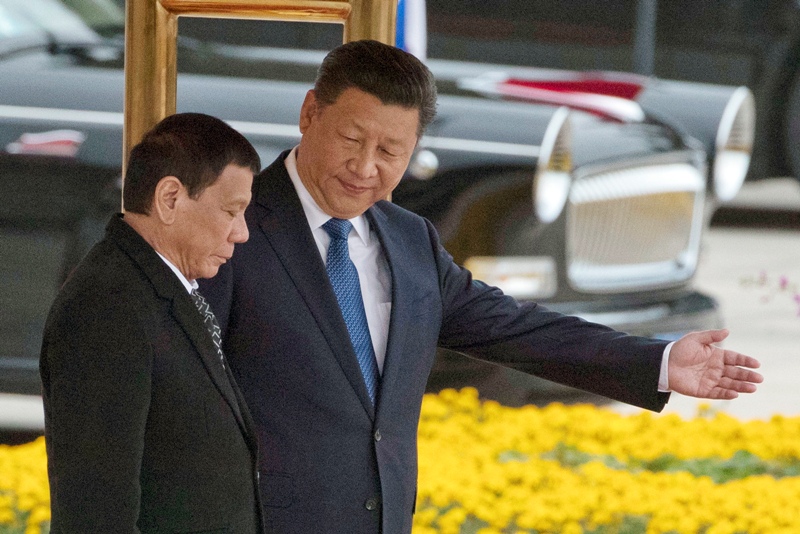What’s in store for the Philippines as it supports China’s new Silk Road

Chinese President Xi Jinping, right, shows the way to Philippine President Rodrigo Duterte during a welcome ceremony outside the Great Hall of the People in Beijing, China, Thursday, Oct. 20, 2016. AP/Ng Han Guan, File photo
The Jakarta Post reports that Indonesia’s president, Joko Widodo (Jokowi), told the 28 participating nations at the recently concluded One Belt One Road (OBOR) summit that “seeing is believing.” In his words, “As President Xi Jinping announced yesterday morning, our vision will be built one by one. There is an English saying of 'seeing is believing,' let's show the world that we are actually building our vision in a concrete way." Jokowi’s statement reflects the difficulty of moving from idealized plans to the realities of implementation, an important insight that would be good for the Philippines to keep in mind.
Despite the amount of press that went into the summit, nothing earth shattering has emerged since President Rodrigo Duterte returned from Beijing. Although he witnessed the signing of a P3.6 billion (US$ 7 million) grant for two bridges in Metro Manila, there seems to be nothing new on the big-ticket projects that the two countries began working on this year. In context, the US$ 7 million is small in comparison to the US$ 9 billion in loans pledged by China to Duterte in Beijing last year. At this stage, our country is still waiting to see how much of the billions will be used and if these projects can be completed without scandal or taint of corruption.
Geopolitics and geo-economics
While we think about how our country fits in the infrastructure wave hitting our region, we can look at the trend in Southeast Asia, as the countries’ respective delegations returned from their trips to Beijing. Apart from Jokowi, Malaysian Prime Minister Najb Razak reportedly also said "I agree with you (President Xi) that Malaysia and China are not only neighbors but are trusted friends." Our neighbors are also playing a balancing game with the great powers.
Moreover, while our government weighs its options, rivalry continues to brew between two heavyweights. Beijing and Tokyo have engaged in stiff competition to win contracts for the financing and construction of mega-infrastructure projects in the region. Inside ASEAN, much like throughout the OBOR participating countries, these initiatives are aimed at boosting connectivity. For China and Japan, these efforts also allow them to promote their construction businesses overseas. In many cases, the cost of some stand-alone projects already approach or even exceed the total US$ 9 billion package offered to the Philippines.
China seems to have gained the upper hand in Laos and Malaysia. In Laos, for example, China is building a China–Laos high-speed rail (US$ 5 billion), expanding the Vientiane airport, and working on urban transport and logistics projects. In Malaysia, China is set to spearhead the Melaka Gateway (US$ 7.3 billion) and the East Coast rail line (US$ 12.74 Billion).
In Cambodia, China has the contracts for the construction of two bridges (Koh Thom and Stung Treng Mekong River) and a national road. In Thailand, China will construct another Thai–Lao Mekong Friendship Bridge; Japan will work on the Bangkok–Chiang Mai high-speed rail (US$ 13 billion). In Myanmar, China has twelve projects, including a Myanmar-China gas pipeline and a Myanmar-China oil pipeline, which opened in April this year after reportedly seeing years of delays. In addition to these two, the projects also include six bridges, a couple of roads, and a shipyard. Japan has a terminal project (Thilawa) and the Yangon-Mandalay railway upgrade.
In Indonesia, Chinese construction looks set for two dams and two reservoirs, three toll roads and a tunnel. Unfortunately, long-held plans for a Chinese-financed high-speed rail (US$ 5 billion) have been repeatedly delayed for reasons that should be familiar to Filipinos: getting land along the route. Japan is in charge of the Jakarta Mass Rapid Transit project, Jabodetabek railway project, and two other roadways. Finally, Japan has bagged many big-ticket items in Vietnam: two ports (Lach Huyen and Cai Mep), three bridges (Nhat Tan, Can Tho, and Red River) and several other roadways.
Conclusion
The summit has provided us with another occasion to look at the pay-off in the president’s friendly approach to our relations with China. His approach emphasizes the importance of taking a quieter stance on our sovereign rights as the key to gaining greater benefits overall. These benefits may come in the South China Sea issue itself, or in the form of better economic outcomes. The infrastructure-driven Belt and Road Summit, which dovetails with the administration’s infrastructure plans, points more strongly to the latter possibility. If so, however, the Philippines must be especially diligent in ensuring returns to its investment.
Dindo Manhit is the president of think tank Stratbase Albert del Rosario Institute, a partner of Philstar.com.
- Latest




























